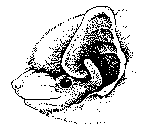 |
Ireland's smallest bat, and also the
commonest, the Pipistrelle is the bat most likely to be seen flying
around soon after dusk, in both urban and rural areas. It has a rapid,
twisting flight as it pursues its tiny prey of midges, mosquitoes
and small moths. A single Pipistrelle (weighing no more than a 2p
piece) may consume as many as 3,500 of these insects in one night,
and is thus, like our other bat species, a very beneficial creature.
Pipistrelles are quite frequently found roosting in houses, although
they also roost in tree holes. In houses, they prefer to occupy confined
spaces such as behind hanging tiles and soffit boards, or between
roofing felt and roof tiles, rather than the main attic space. Scientists
now believe that this bat is actually two distinct species, following
recent research in Britain. The "new" species is nicknamed the "bandit
bat" because of its dark face. It has not, as yet, received a formal
scientific name. The two types of Pipistrelle also differ in the echolocation
frequencies they use, and are called "phonic types". Both are found
in Ireland. Those echolocating at 55kHz appear to be more numerous
here than their 45kHz cousins. |
 |




